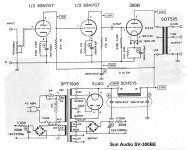What is the tube in the middle that has 100 next to it?
as Per this link, it’s another 6sn7
https://www.qoo10.sg/item/HIFIVV-AUDIO-HIFI-TUBE-AMPLIFIER-HI-END-300B-PCB-CLASS-A-TUBE/626134718
as Per this link, it’s another 6sn7
https://www.qoo10.sg/item/HIFIVV-AUDIO-HIFI-TUBE-AMPLIFIER-HI-END-300B-PCB-CLASS-A-TUBE/626134718
It is a classic 300b+6SN7 circuit, but there is a mistake in the middle tube, it shows a triode-strapped tetrode, while in reality is just a triode, half of the 6SN7.
The schematic's annotation is not very precise to say the least, it shows a 100uf resistor, capacitors without values and without voltages, etc.
The schematic's annotation is not very precise to say the least, it shows a 100uf resistor, capacitors without values and without voltages, etc.
Last edited:
The middle tube isn't a 6SN7 and should not be a 6SN7. A 22K load resistor is too low for a tube with a Ri of 7.7K. Plus you will have far too much gain. You need a proper driver like a 6AH4 which is excellent and sounds as good as any other indirectly heated tube I can think of as a driver, and better than most of the usual suspects.
I have seen many circuits using 6SN7 as a driver for a 300B. Having said that I have never built anything with a 300B, therefore Andy's opinion is probably the right one.
But, the link supplied in #2 included a PCB board and the exact same schematic the OP is asking about, and I can only see 4 sockets, 2x300B and 3 octal ones, for 2x300B, 2x6SN7 and 1x5U4.
P.S Some are pretty happy with 6SN7 as 300B drivers: https://www.enjoythemusic.com/diy/0709/flesh_blood.htm
But, the link supplied in #2 included a PCB board and the exact same schematic the OP is asking about, and I can only see 4 sockets, 2x300B and 3 octal ones, for 2x300B, 2x6SN7 and 1x5U4.
P.S Some are pretty happy with 6SN7 as 300B drivers: https://www.enjoythemusic.com/diy/0709/flesh_blood.htm
Last edited:
I've used a 6SN7 to drive a 2a3 in SE and the sound was pretty good. It worked with only those 2 stages at moderate volumes in a compact room.
But given that one 6SN7 is enough to drive a 2a3 why put another valve with a gain of x20 in the circuit? You only need an added gain of x5 or so for your 300b which points to a low Ri driver with plenty of current and grunt, like a 6AH4 or a 6V6 in triode. That kind of thing.
But given that one 6SN7 is enough to drive a 2a3 why put another valve with a gain of x20 in the circuit? You only need an added gain of x5 or so for your 300b which points to a low Ri driver with plenty of current and grunt, like a 6AH4 or a 6V6 in triode. That kind of thing.
I would like to go back to the source and validate things if possible.
https://www.aliexpress.us/item/2255800854683736.html
https://www.aliexpress.com/i/2251832688747726.html?gatewayAdapt=4itemAdapt
probably copied by a shop that also send you handbags, toxic painted toys
🤣
Your schematic seems to line up.
I thought the “middle tube” had to be the second half of a 6SN7, but the way it was depicted with a screen confused me.
Now, on to verifying all the values.
This isn't your "standard" 6SN7-300B amp design a la Reichert, Sun and others. Mainly because the 6SN7 is cap coupled to the 2nd stage. This gives the 2nd stage full voltage headroom, something the direct-coupled designs lacked and probably accounts for a lot of their shortcomings. The 2nd stage should be a power pentode so triode strapped it has a nice low plate resistance. Could be a decent circuit but curious that everything but the pentode is identified. Designs with this much gain should also be integrated amplifiers - have a pot upfront - way too sensitive and thus more noisy as power amps.
There is no pentode in their implementation. It seems to use the second half of 6SN7 as the second stage.
But, as you said, the second half of the 6SN7 is cap coupled, so the schematic above doesn’t quite fit.
But, as you said, the second half of the 6SN7 is cap coupled, so the schematic above doesn’t quite fit.
The middle stage of your posted schematic in post #1 is obviously a pentode/tetrode in triode, with a 100 ohm resistor between grid 2 and anode.
Then this isn't what this schematic is
Clearly no pentode on that board. So, either the schematic is not accurate or that PCB has nothing to do with the schematic.
Stephe, a member of this forum, modified this schematic in cascode with a great improvement. I built both and the one modified by Stephe is much better in distortion, power and clarity of sound. Power supply with 320-0-320vac is not enough. Much better 375-0-375 vac The construction is documented very well indeed with a series of videos. This is only my opinion.
76 volts on the plate e of a 6SN7 is way too low likewise running it at ~2mA. The first stage is cap-coupled hence its operating point is independant of the second stage and the 6SN7s are very linear tubes so why throw away their strengths, especially when you have 420V to play with? You should have at least 150 volts on the plate and >5mA current. Try reducing the dropping resistor to 22k, keep the 33k plate resistor and adjust the cathode resistor for 5mA current. Or lower the dropping resistor even more and up the current, 6SN7s like get very linear above 8mA. And errr… has anyone noticed the 6V6 has no plate resistor 🤣🤣🤣?
- Home
- Amplifiers
- Tubes / Valves
- Can you identify this 6SN7 / 300B circuit?
